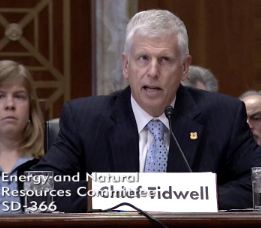
The Chief of the U.S. Forest Service told a congressional committee on Tuesday that he expects the wildfire suppression budget to be “tight” this year and that he plans to rely more on the military’s eight MAFFS air tankers than the agency did last year.
In front of the Senate Committee on Energy and Natural Resources, Chief Tom Tidwell read a prepared statement about the FY 2013 USFS budget and then answered questions from members of the committee.
While the proposed budget fully funds the 10-year average cost of wildland fire suppression operations for FY 2013, Chief Tidwell said that based on current and predicted conditions, this year “it’s going to be tight for us to have adequate funding for fire suppression”.
Two senators, Ron Wyden of Oregon and Lisa Murkowsk of Alaska, gave their opinions and asked detailed questions about the availability of air tankers. Senator Wyden said that the USFS should speed up the adoption of new technology, and gave an example of a very large air tanker in his state that has seven times the capacity of standard large air tankers. He was obviously referring to Evergreen’s 747, Tanker 979, which holds 20,000 gallons. The USFS has not been interested in offering exclusive use contracts for any very large air tankers (VLAT) and has only made call when needed contracts available. Evergreen has said they cannot continue to make the 747 available on a CWN basis with a very uncertain income stream. Another VLAT vendor, 10 Tanker Air Carrier, did accept the CWN contract and is struggling to manage their two DC-10s with no guarantee of income.
Senator Wyden told Chief Tidwell that he wants Mr. Tidwell within 30 days to respond to him and a bipartisan group of Senators explaining what the USFS will do to consider “new technology” and the use of VLATs.
Chief Tidwell said this year the agency will contract for two scooper air tankers (presumably CL-215s or CL-415’s) for the first time. He said the recent request for proposals for “next generation” air tankers will produce three additional air tankers this year and four more in 2013. Adding the two scoopers and three next-gen air tankers would bring the total from 11 last year to 16 this year. This compares to the 19 at the beginning of 2011, the 11 at the end of 2011, and the 44 in 2002. Chief Tidwell said that under the air tanker strategy announced recently by the USFS, he expects there will be 18 to 28 large air tankers eventually under contract.
He said there will be 30 large Type 1 helicopters on national contracts this year compared to 34 last year, but not all of those last year were Type 1, so this year there will be a net increase in the number of gallons that can be carried.
Chief Tidwell also testified that he expects to rely more this year than last year on the Mobile Airborne Fire Fighting Systems (MAFFS) C-130 air tankers operated by the Air National Guard and the Air Force reserve. But Senator Murkowski confronted him with the fact that “the military does not desire to take on additional responsibilities with the C-130s”. She said “We need to be very cognizant of the stresses we are putting on the [Air National Guard and Air Force Reserve] system.”
Chief Tidwell responded:
The Department of Defense is not interested in expanding their mission to assist in this, but also at the same time they are going to continue to work with us to provide these air national guard unit planes when we need them after everything else is fully committed. It is part of our strategy to help bridge. If we have an active fire season we are going to have to rely on those eight MAFFS planes.
A video of the 110-minute hearing can be found on the Energy and Natural Resources Committee’s web site.


What Happend To P. D. S. in otherwords Prevention, Detection, Suppression More Money on Detection and prevention
Maybe the Chief can contract with SoCal Counties and CalFire to provide fire protection on the 4 National Forests, and use the savings to buy air tanker coverage for the rest of the 150+ National Forests around the US as well as the National Parks, Federal Wildlife Refuges, Indian Reservations and BLM Public Lands that are dependent on air tanker support?
Maybe it would be better if he WAS smokin’ something.
Mr. Tidwell, two questions. First. If? Second. What are you smoking?
Good effort Tom!
You know this is the 3rd yr of this and Mr Tidwell is hoping for those C130J’s on a daily basis.
Nice work.
Don’t “wanna” use 10 Tanker LLC and Evergreen? Pretty shortsighted for a “visionary” organization that leans pretty heavy on aviation assets.
Better hope those combatant commanders don’t have any pressing issues this summer.
Yup nice of all of our taxpaying dollars are hard at work “discussing” the needs. We will “see” if these “discussions” are completed in that 30 day window. After that 30 day discussion, there ought to be a process that encourages Mr Tidwell to produce that wonderful RAND report so that the entire Intermountain West, Southern and SE US can see how effective the last 10 years and countless”studies” have assisted improving the current situation.
Maybe Congress can force USFS to bring Aero Union and H&P brotherhood back to a revivival, bring all the tooling, or buy it back, and force some single source contracts down the USFS contract halls.
The education of Mr Tidwell and the “leadership” at the USFS FAM WO still continues to amaze the the general public. BUT BS and dependance on the US Air Force can only go so far!!!